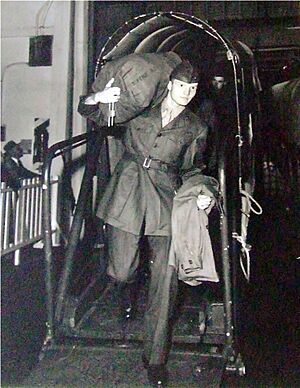James E. Brewton facts for kids
James Edward Brewton (born November 4, 1930 – died May 11, 1967) was an American artist. He was a painter and printmaker. His art style mixed expressionism, graffiti, and a unique philosophy called Pataphysics.
James Brewton was born in Toledo, Ohio. He passed away in Philadelphia when he was 36 years old. At that time, he was becoming known as one of Philadelphia's best artists.
Contents
His Journey as an Artist
When he was a teenager, James Brewton learned drawing at the Toledo Museum of Art. He also studied painting with an artist named John Charvet.
Serving His Country
At age 21, Brewton joined the Marines. He served in the Korean War. He did very well and became a sergeant. However, being in the war changed him. He became a pacifist, meaning he believed in peace and was against war. He even painted artworks that protested the Vietnam War. His health was also affected by his time in the military.
Art School and Influences
Even though his later art looked like graffiti, his early training was traditional. He used the G.I. Bill to go to art school. This program helps veterans pay for education. He studied at the Ruskin School in England from 1954 to 1955. Then, he went to the Pennsylvania Academy of the Fine Arts (PAFA) from 1955 to 1958.
At PAFA, Brewton was mentored by famous artists like Franklin C. Watkins and Hobson Pittman. Pittman even owned a self-portrait painted by Brewton.
A famous artist named Marcel Duchamp gave talks at PAFA. Brewton was inspired by Duchamp's ideas throughout his life. Brewton also worked at The Print Club (now The Print Center). There, he saw art by Asger Jorn and the CoBrA group. He loved their wild and colorful art. Brewton became friends with Jorn and even lived in Denmark for months. Other artists who influenced him were André Breton and Alfred Jarry. These European, avant-garde (new and experimental) ideas were quite unique for an artist in Philadelphia during the 1950s.
Awards and Recognition
Brewton's art won many awards and prizes. Critics in Philadelphia and New York praised his work even when he was still a student. He won the important $1000 Schiedt prize. His obituary in The Philadelphia Inquirer said that he won this award at a young age (28). Many famous artists had won it later in their careers.
Travels and Later Work
From Philadelphia, Brewton traveled whenever he could. He visited Spain, France, England, and Denmark. In 1962, he lived in Denmark with writer Barbara Holland. In 1964, Brewton lent some of his own artworks to the Philadelphia Museum of Art for an exhibition about Asger Jorn.
In his last years, Brewton's art was shown at Kenmore Galleries in Philadelphia. His prints were selling well. The Philadelphia Museum of Art even has some of his prints in its collection. His art changed over time. He started with colorful, CoBrA-inspired pieces. Then, he moved to more muted, wall-like artworks that included graffiti.
By 1965, his art combined graffiti with Alfred Jarry's philosophy called 'Pataphysics. Brewton called these works "Graffiti Pataphysic." He also continued to paint portraits.
When he passed away in 1967, Brewton had already had several solo art shows. Museums were starting to show interest in his work. Nessa Forman, a writer for The Philadelphia Inquirer, said that Brewton was "an artist who was ahead of his time." She described him as brilliant, sensitive, and someone who loved his art.
His Passing and Legacy
James Brewton passed away on May 11, 1967. Just four days after his death, his work was shown at the Socrates Perakis gallery in Philadelphia. His art was displayed alongside other artists like Jim McWilliams and Thomas Chimes.
A year later, a memorial show was held at the Peale Galleries at PAFA. Hobson Pittman wrote in the show's catalog that Brewton was "a truly gifted artist." He said that Brewton always searched for deep and meaningful symbols in his art.
Recent Exhibitions
After a memorial show in 1971, Brewton's artwork became scattered. He was slowly forgotten by the public. However, his only child did not forget him. In 2008, Brewton's daughter and friends started the James E. Brewton Foundation. They began looking for his artwork. They found hundreds of paintings, prints, and other art pieces.
In 2012, Brewton's portrait of Edgar Allan Poe was shown at the Woodmere Art Museum. In 2014, he had his first solo exhibition in 43 years at Slought. This show was part of a conference at the University of Pennsylvania. Edith Newhall, a critic, wrote that the show highlighted Brewton's Pataphysics-influenced works. She felt that watching his creative journey showed he knew his time as an artist would be short.


